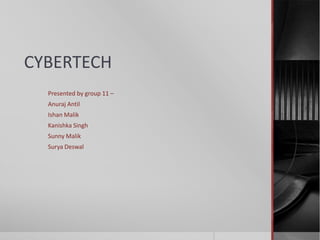Recommended
More Related Content
Similar to Cybertech
Similar to Cybertech (20)
INFOGRAPHIC: The Game of IT Infrastructure: Cloud vs In-House IT Infrastructure

INFOGRAPHIC: The Game of IT Infrastructure: Cloud vs In-House IT Infrastructure
Advantages Of Robotic Machine In Industries - Grind Master

Advantages Of Robotic Machine In Industries - Grind Master
Cybertech
- 1. CYBERTECH Presented by group 11 – AnurajAntil Ishan Malik Kanishka Singh Sunny Malik Surya Deswal
- 2. POINTS OF FAILURE High initial cost Efficiency Lack of skilled manpower Seasonal effects Selling as whole not module by module High operating cost
- 3. HIGH INITIAL COST To implement cybertech it required a high initial cost which most firms were unwilling to spend. The cost of the system was 13 million australian dollars but this cost had to be bought down to 5 million australian dollars for it to be viable. Also the floor area required for the project was 1.5 times more as compared to the conventional plants which added to the cost.
- 4. EFFICIENCY The plant was not running efficiently as expected at Wollagong. Plant ran at 80% uptime versus 99.5% as specified. Also it was running at the same operating speed as compared to conventional plants.
- 5. LACK OF SKILLED MANPOWER To work on cybertech skilled workforce is required. According to australian bureau of statistics majority of workers were had fewer skills or were semi skilled. Also culturally people didn’t preferred working in meat companies. Training people to work on cybertech would add up to the cost incurred by the firm in addition to the setup costs.
- 6. SEASONAL EFFECTS When there were rains or due to some other reasons production was less or was stopped workers couldn’t be laid off as lot of expenditure was required to train them to make them skilled to work on machines as compared to conventional plants. This would result in incurring more costs in times of less or no production.
- 7. SELLING AS WHOLE NOT MODULE BY MODULE Cybertech was to be sold as a whole products not in parts(modules). This led to huge investment for the firm willing to install cybertech. Due to this small firms were unable or unwilling to buy this. Alternatively if it was to be sold module by module it would have fetched more revenues and more firms would have benefitted from this project. This alternative would have led to more flexibility in level of automation as desired by firms according to their resources.
- 8. HIGH OPERATING COST For the cybertech 2 the minimum quantity to be produced for the plant to be cost effective came out to be 4827.2 tonnes for the year 1994 as compared to 1723.5 tonnes for the phoenix plant. It is the break even quantity.
- 9. THANK YOU
